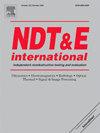结合激光激发边缘共振和ZGV共振测量各向同性均匀板的波速和整体厚度分布
IF 4.1
2区 材料科学
Q1 MATERIALS SCIENCE, CHARACTERIZATION & TESTING
引用次数: 0
摘要
分析了将最低阶零群速度模式(S1-ZGV)与任意高阶共振相结合的常用ZGV共振方法在评估板块波速时的局限性。针对激光激发边缘共振和S1-ZGV相结合的ZGV共振方法存在的信噪比低、高阶共振难以识别等问题,提出了一种新的ZGV共振方法。此外,该方法克服了ZGV在板边缘处消失的问题,可用于板边缘厚度的测量。导出了S1-ZGV共振与边缘共振的频率比与材料泊松比之间的关系。实验中,利用激光超声技术观察了板内的ZGV和边缘共振。最后,精确地确定了板材的整体厚度和材料的波速。本文章由计算机程序翻译,如有差异,请以英文原文为准。
Combining laser-excited edge resonance and ZGV resonance for measuring wave velocities and global thickness distribution of isotropic homogeneous plates
The limitations of the common ZGV resonance method, which combines the lowest-order Zero Group Velocity mode (S1-ZGV) with an arbitrarily high-order resonance, for assessing the wave velocities of plates, were analyzed. A novel ZGV resonance method, combining laser-excited edge resonance and S1-ZGV, is proposed to solve the problems of low signal-to-noise ratio and the difficulty in identifying of higher-order resonances. Furthermore, this method overcomes the problem of the ZGV disappearing at the plate edge and can be used to measure the plate edge thickness. The relationship between the frequency ratio of the S1-ZGV resonance to the edge resonance and the Poisson's ratio of the material was derived. Experimentally, the ZGV and edge resonances within the plate were observed using laser ultrasonic technology. Finally, the global thickness of the plate and the wave velocities of the material were accurately determined.
求助全文
通过发布文献求助,成功后即可免费获取论文全文。
去求助
来源期刊

Ndt & E International
工程技术-材料科学:表征与测试
CiteScore
7.20
自引率
9.50%
发文量
121
审稿时长
55 days
期刊介绍:
NDT&E international publishes peer-reviewed results of original research and development in all categories of the fields of nondestructive testing and evaluation including ultrasonics, electromagnetics, radiography, optical and thermal methods. In addition to traditional NDE topics, the emerging technology area of inspection of civil structures and materials is also emphasized. The journal publishes original papers on research and development of new inspection techniques and methods, as well as on novel and innovative applications of established methods. Papers on NDE sensors and their applications both for inspection and process control, as well as papers describing novel NDE systems for structural health monitoring and their performance in industrial settings are also considered. Other regular features include international news, new equipment and a calendar of forthcoming worldwide meetings. This journal is listed in Current Contents.
 求助内容:
求助内容: 应助结果提醒方式:
应助结果提醒方式:


